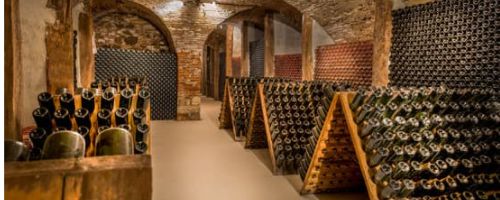No products in the basket.

Why does champagne taste like it does? This ‘quick & general’ guide to the champagne flavour profile looks at what champagne tastes like and the reasons why. Essentially, why champagne tastes like champagne. It compares the production of champagne and other wines made by the champagne method to the production of other sparkling wines like prosecco because the differences in the techniques used in the winery have perhaps the biggest influence on the flavour profile.
Other things of course affect the taste of sparkling wine not least the grape varieties, terroir and weather variations, the sweetness and alcohol level so there are many contributing factors that lead to such a wide range of sparkling wine types and flavours. But here the focus is on techniques in the winery. You can also find an explanation of some of the terms you will find on Champagne labels.
We all know and love champagne but did you know that there are a number of other sparkling wines made in the same way (known as the champagne method)? These include:
Grapes of course are a major factor in the taste of any wine. English Sparkling Wine tends to be made from the three main grapes used in Champagne, Chardonnay, Pinot Meunier and Pinot Noir but Cava, Franciacorta, Saumur, Vouvray and the Crémants allow more latitude. Manoir du Carra’s Crémant de Bourgogne is a Blanc de Blanc Crémant as it is produced exclusively from white grape, Chardonnay.
What all these wines have in common is the champagne method of production and this probably has the biggest influence on the flavour profile. The Champagne method in a nutshell means that the second fermentation takes place in individual bottles rather than in a pressurised vat or tank. The second fermentation takes place after yeasts and sugars are added to the base wine created by the first fermentation and the interaction of these substances creates the carbon dioxide or bubbles in the wine and increases the alcohol level a degree or so.
What is the significance of a fermentation in bottle you might ask. Well, it means that the wine has exposure to the yeast cells as they die and then break down, a process known as yeast autolysis. The compounds released into the wine from interaction with the dead yeast cells or lees is essentially where the aromas and flavours of champagne are developed and why champagne tastes the way it does. The bottles are stored for many months (at least 15 for champagne) and sometimes for years, initially flat to maximise the contact of the wine and the lees. Subsequently, they were traditionally moved to riddling racks or “pupitres” like those below and turned over time to move the sediment to the neck of the bottle ready for removal. This process is now more often than not done by a mechanised palette known as a “gyropalette”.

Of course by the time you have your glass of champagne there is no yeast left in the wine but it has had a major impact on the taste. Autolysis is responsible for the biscuity, brioche type of aromas and flavours associated with champagne and other champagne method wines. It also helps create complexity and the rich, rounded texture of the champagne. The source of these toasty flavours is often assumed to be from oak but in most champagne method wines it is from the lees. A wine left on the lees for longer will show more intense bready aromas and flavours so aging is also a factor.
For sparkling wines not produced by the champagne method this second fermentation takes place in a large vat or tank so although there may be some interaction with the lees, especially if they are stirred as sometimes happens, the effect is much more diluted or subtle. Sparkling wines like prosecco are usually fermented in tank to preserve the fruity taste of the grapes rather than to take on any secondary aromas or flavours.
Conclusion? The champagne method leads to richer, more rounded wines with bread and biscuit characteristics (in addition to fruit) and usually finer, more persistent bubbles.
Non-vintage or NV: the grapes used do not all come from one harvest, i.e. they come from different vintages. Most champagne is NV and every champagne house has its own house style of NV champagne. They use mainly the grapes from one vintage but they add some reserve wine from past years to blend with it and to create a consistent style year on year. This is why you can rely on non-vintage champagne from a particular champagne house e.g. de Castellane (my favourite) tasting the same each time you buy it. Of course one champagne house’s style can vary greatly from another house’s style.
Vintage: for champagne mainly (and occasionally for other sparkling wines) this means that the grapes used are all from one vintage and so the wine will reflect the vintage and vary year to year. In fact a vintage is only declared in the best years so you won’t find a vintage champagne from every year. Read more about this subject in my blogpost on vintage Champagne.
Prestige Cuvée is a term used by some wineries and champagne houses to indicate their best wine, usually available in limited quantities and at a higher price.
Blanc de Blancs essentially means that a white champagne is made only from white grapes (so no Pinot Noir or Pinot Meunier is added) and this style is a little crisper with more citrus fruit flavours.
Blanc de Noirs therefore means a white champagne made solely from black grapes, Pinot Noir and/ or Pinot Meunier, the juice, by the way, being clear or ‘white’. These black grapes give champagnes a little more structure and richness often making these wines more weighty in terms of body.
In recent years English wine producers have begun to expand their product ranges to include some of these styles.
© 2014-2024 Wines with Attitude Ltd | VAT Reg. No. 181 2419 22 | Registered in England 08918466 | Fiveways, 57-59 Hatfield Road, Potters Bar, Herts, EN6 1HS